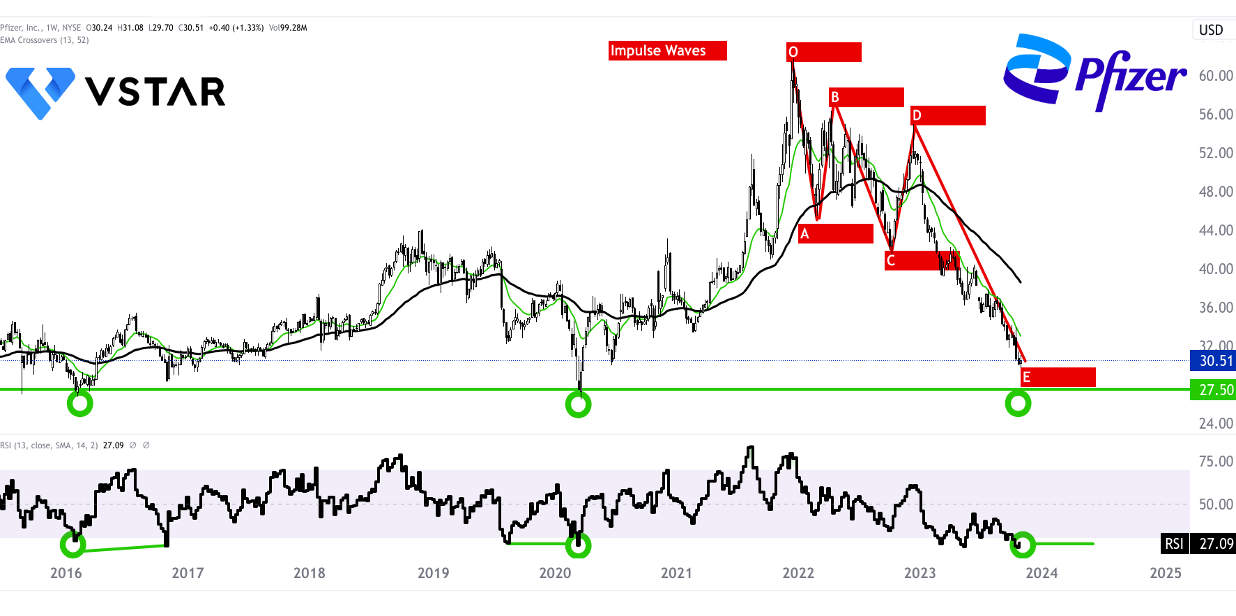Pfizer (NYSE: PFE) is a pharmaceutical company with a strong global presence, and it has demonstrated significant growth potential in various therapeutic areas. The analysis examines the fundamental strengths and weaknesses of Pfizer, focusing on Q3 2023, which support and may hinder the company's rapid growth potential.
Fundamentals Supporting Pfizer's Rapid Growth Potential
Global Reach and Patient Impact: Pfizer has a vast global reach, with over 457 million patients treated with their medicines and vaccines during the first nine months of the year. This extensive patient impact indicates Pfizer's ability to address global health needs and offers a significant growth potential, especially in critical therapeutic areas like oncology, cardiovascular disease, and anti-infectives.
Revenue Growth in Non-COVID Products: Pfizer's non-COVID products have shown robust performance, with a 10% operational revenue growth in the third quarter. This growth demonstrates Pfizer's diverse product portfolio and its ability to generate revenue beyond COVID-related treatments. This steady revenue stream provides a foundation for growth.
Product Diversification: Pfizer has strategically diversified its product portfolio through acquisitions like Nurtec, Vydura, and Oxbryta. These acquisitions have contributed to global revenues, addressing unmet medical needs in areas such as migraine, sickle cell disease, and other diseases. Diversification in therapeutic areas offers revenue growth opportunities.
Market Expansion: Pfizer's launch of ABRYSVO for respiratory syncytial virus (RSV) with maternal immunization approval presents a unique market expansion opportunity. With approximately 80 million adults eligible for RSV vaccination and a significant number of pregnant women eligible for maternal immunization, ABRYSVO has the potential to become a significant revenue contributor.
Underserved Markets: Pfizer is addressing underserved markets, such as primary care in the migraine marketplace and sickle cell disease in regions with limited resources. By recognizing unmet needs and providing effective solutions, Pfizer can continue to grow in these markets.
Education and Awareness: Pfizer's focus on educational activities to expedite diagnosis and treatment for diseases like transthyretin amyloid cardiomyopathy and other conditions demonstrates its commitment to improving patient outcomes. This can result in increased product adoption and revenue growth.
Pipeline Expansion: Pfizer's commitment to launching new products and indications, with 13 out of 19 potential launches executed, reflects a strong pipeline. These launches can drive future revenue growth as new products are introduced to the market.
Future Potential from Seagen Acquisition: The proposed acquisition of Seagen, expected to close in late 2023 or early 2024, holds the potential to have a significant impact on human health by addressing cancer. One in three people will be diagnosed with cancer in their lifetime, highlighting the growth potential in this area.
Financial Strength: Pfizer's ability to raise $31 billion in acquisition financing and expectations of incremental risk-adjusted revenues in excess of $10 billion, along with cost efficiencies of $1 billion, demonstrate the company's financial strength and its capacity for further investments and growth.
Weaknesses That May Hinder Pfizer's Growth Potential
COVID-19 Dependency: Pfizer's Q3 results were significantly impacted by COVID-19 products, with a 41% operational revenue decline. The company's dependency on COVID-19 products like Paxlovid and Comirnaty exposes it to revenue fluctuations, making it challenging to achieve consistent growth once the pandemic subsides.
Non-COVID Product Revenue Gap: While Pfizer has demonstrated strong revenue growth in non-COVID products, the revenue gap between COVID and non-COVID products remains significant. The company needs to bridge this gap to achieve sustainable growth.
Inventory Write-offs: Pfizer's financials in the third quarter were negatively impacted by non-cash inventory write-offs of COVID-related inventories, totaling $5.6 billion. These write-offs can affect the company's profitability and limit its ability to invest in growth initiatives.
Lower Revenue Guidance: Pfizer lowered its full-year revenue guidance from a previous range of $67 billion to $70 billion to a new range of $58 billion to $61 billion. This reduced guidance indicates challenges in achieving substantial revenue growth in the short term.
Reduced Earnings Per Share (EPS): Pfizer's adjusted diluted earnings per share (EPS) for the full year were revised down significantly, from the original range of $3.25 to $3.45 to the new range of $1.45 to $1.65. This suggests that achieving high EPS in the near future may be challenging.
Fluctuating Foreign Exchange Impact: Foreign exchange movements had a small unfavorable impact on Q3 revenues and adjusted diluted loss per share, indicating that currency fluctuations can affect Pfizer's financial performance.
Competition in the Market: Pfizer faces competition from other pharmaceutical companies in various therapeutic areas. This competitive landscape may pose challenges to sustaining market share and pricing power, affecting revenue growth.
Long-Term COVID-19 Impact: The future of Pfizer's COVID-19 products, especially vaccines, remains uncertain. While booster shots and ongoing vaccination campaigns provide revenue, the long-term outlook may be affected by changing vaccination requirements and the eventual control of the pandemic.
In conclusion, Pfizer has several fundamental strengths that support its growth potential, including its global reach, revenue growth in non-COVID products, product diversification, market expansion, addressing underserved markets, a strong pipeline, and a proposed acquisition. However, the company also faces challenges, such as COVID-19 dependency, inventory write-offs, reduced revenue guidance, and competitive pressures.
Pfizer Stock (PFE) Technical Take

Source: tradingview.com
In the weekly time frame, Pfizer stock price is formulating the last impulse wave under Elliott Wave theory. Notably, this wave is heading towards a multiyear low, with RSI under 30 representing a solid opportunity to enter a long position. There may be correcting waves (1-2-3) in the coming weeks; however, value investors can take advantage of this momentum to establish a multiyear position. The Pfizer stock price may create a consequential low at the same level, near $27.50, to form a double bottom with RSI bullish divergence, similar to the 2016 and 2020 lows. On the downside, if the PFE stock price breaches this level, investors can opt for dollar averaging, as PFE stock may demonstrate rapid bullish moves with potential positive developments in the pipeline in short- to mid-term.




